LIFE'S GRAND ADVENTURE
When performance meets precision on the water, the Grand G680 certainly delivers. This isn’t just another rigid inflatable boat – it’s a carefully engineered platform that bridges the gap between recreational cruising and serious maritime capability.
At 6.8 metres, the G680 hits that sweet spot where size translates to stability without sacrificing the agility that makes RIBs so appealing. Whether you’re cutting through choppy coastal waters, exploring hidden coves or pressing it into action as a tender for your superyacht, this craft promises the kind of versatility that recreational boaters demand with boatloads of styling. But what sets the Grand G680 apart in an increasingly crowded market? The answer lies in the details – from its robust construction and thoughtful layout to the way it handles in conditions that would challenge lesser vessels. This is a boat built for those who understand that compromise isn’t an option when it comes to safety, performance or reliability on the water. We take a virtual stem to stern walk around of one of the most popular sellers in the Grand range. Dan Arscott, Managing Director at Grand Boats Australia, gives me the cook’s tour.
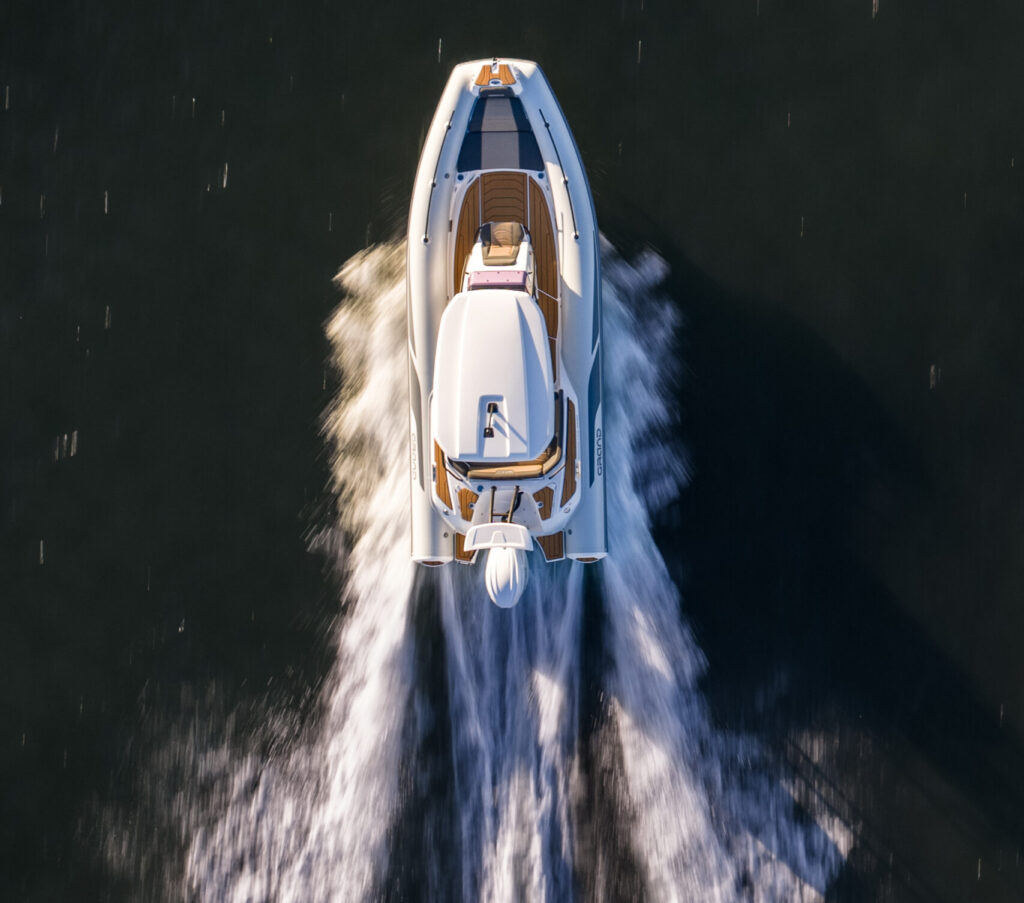
IN THE BEGINNING (OR THE BOW)
Underneath the bow you have the five-kilogram stainless steel anchor, with 50 metres of stainless-steel chain and then there is another locker under the forward seat for the toys. And before we move on it’s worth highlighting this vessel has an abundance of storage lockers, cup holders and powerful speakers in at the bow as well as smattered around in handy, wellthought-out places all over the boat. It could be a trap for young players, wondering about the declines in their vessel’s performance all the while loading up with more must-have items for cruising, there is so much storage for a boat of this size.
The bow space converts into one big sunbed when you jigsaw the one central board and two outside boards into place. It’s worth mentioning at this point the sun cover that goes from the bow to the forward part of the hardtop. It has a twin cover that goes from aft of the hardtop and covers over the stern, pretty much making a no sunbaking zone for the whole vessel when required, which is great for a ranga like me.
The tube-mounted bow rails are installed around 10 centimetres above the tube, a clever way of increasing the freeboard without losing the lines. The cleats pop up and down, which I noticed on the stern as well, where there is a clever little rope locker near the cleat. The locker lid has a corner that you can tail a rope through without opening the locker – ingenious.
The console locker is behind the console seat, a forward-facing seating position. The back of the seat becomes a secret squirrel door; it took me a minute to find the not-so-obvious latch which reveals tonnes of space for toys or the aforementioned sunbed components. This compartment also provides plenty of access to the mystery behind the console, with the fuse boxes and trip switches well tagged and labelled.
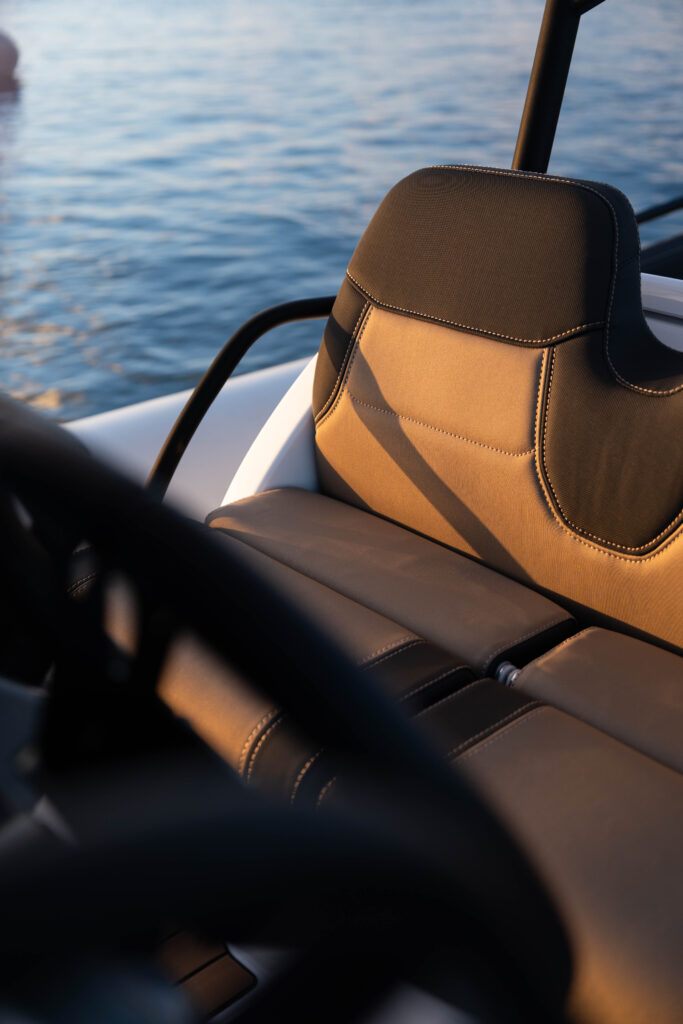
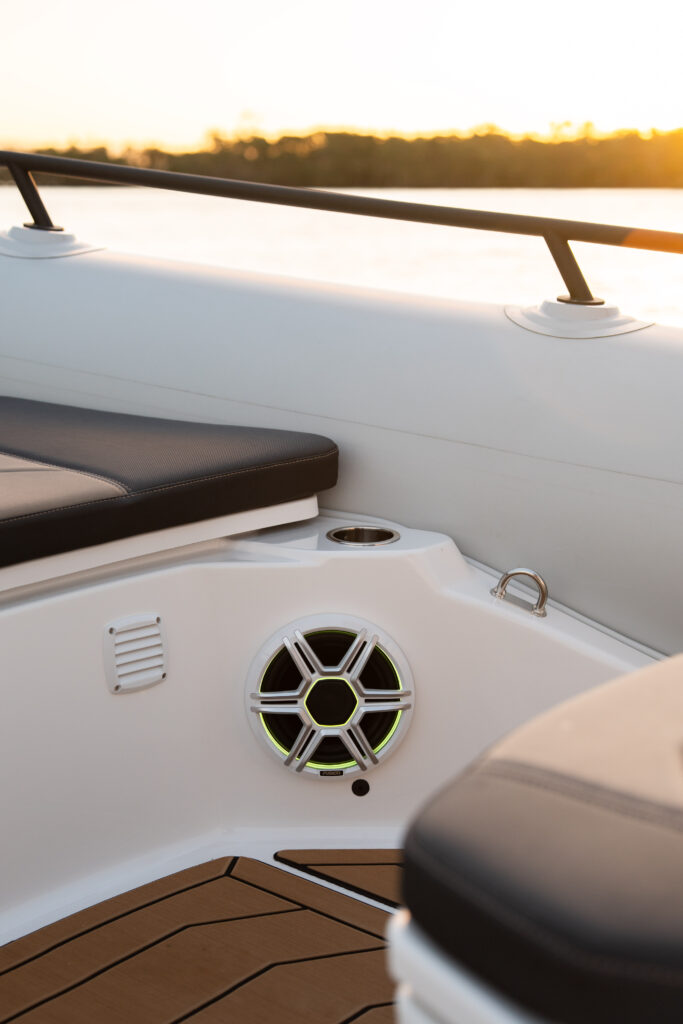
T-TOP
On top of the gel-coated, ultra-white T-top is the anchor light and the darndest VHF aerial I have ever seen. The whip has been replaced by a small unit that looks like a fat shark’s fin. Dan says: “We use the T-top for electronics such as VHFs, radars and lightbars, while the ski arch is for any electronics that need to be mounted further back and high, great for commercial boats, or if you want a radar reflector mounted.”
THE DASHING DASH
The glove box has 12-volt twin USB chargers. There is a wireless phone charger on the dash which Dan talks about with the enthusiasm of man first seeing fire. “I don’t know if you’ve used this before, but that’s a really nice thing to hold your phone in.” “Yes,” I replied, “I used it last time I was on board the Grand G750.” The 9-inch Garmin is the info centre on the dash which runs all the Yamaha data, so there’s no need for any big round gauges. Laid out for dummies are the very elegant silver buttons which have their purpose etched into each button – fridge, water pump, bilge override, anchor and horn.
THE G-SPOT
The dash is adorned with a sport steering wheel with a Grand embossed hub; in fact it is worth pointing out the Grand Boats symbol and name which is quite a stylish G. It is in quite a few spots around the boat, a nice touch to the aesthetics. It appears on the hull in a couple of places – the helm, the back of the helm, where you put your feet while sitting at the helm. Also on the front and rear seats and laser cut into the black metal stands that hold up the T-top, just in case you were to forget what boat you are on. For mine, although a slight overkill, they did a nice job with the branding.
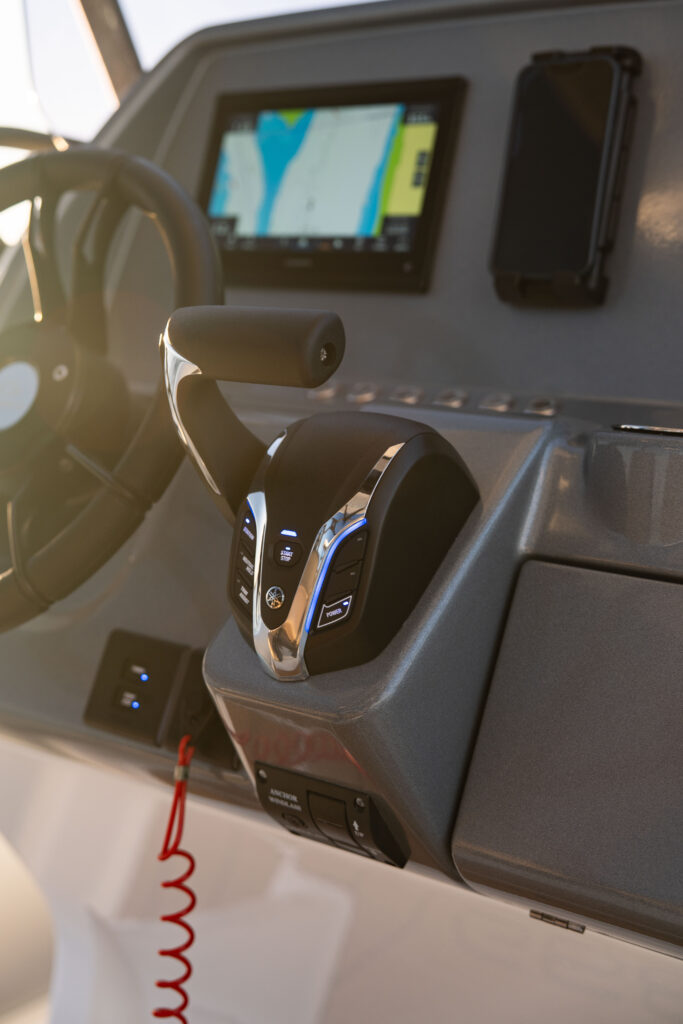
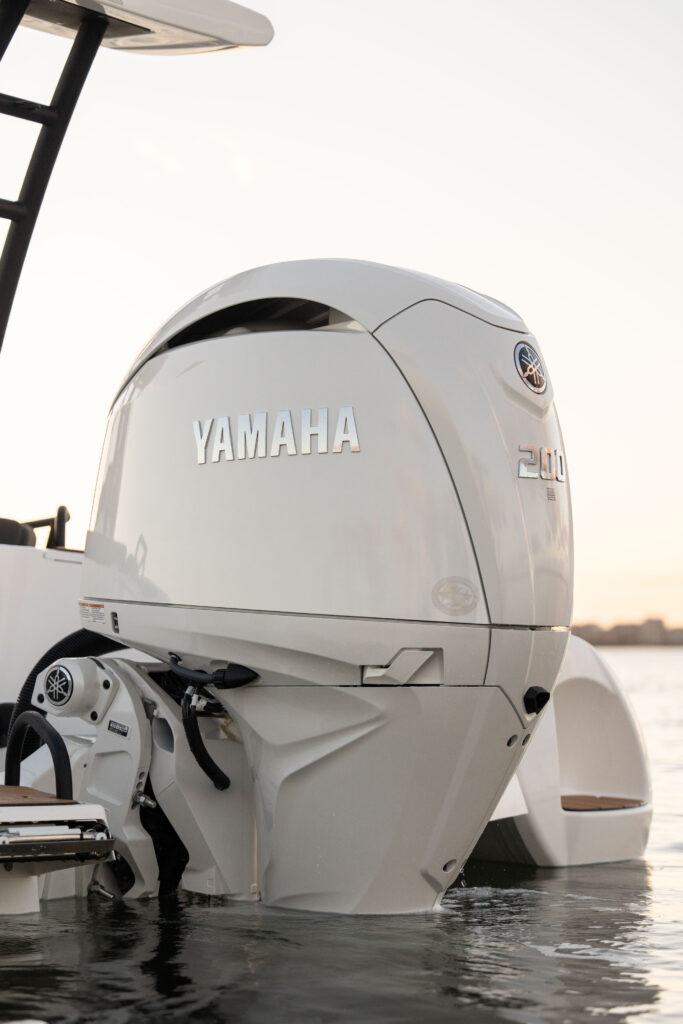
THE HELM STATION
The Yamaha kit makes this boat exciting with the electric steering meaning you turn the helm with your finger. And then there’s the throttle and control box, which has both normal throttle controls or cruise control which can be set to RPM or speed. Handy stuff when hamstrung by the waterway speed restrictions of the Gold Coast and tides that change direction around every turn. You can simply set it to your required speed over-ground, and it will adjust the revs of the engine to accommodate, regardless if you are pushing the tide, or it is behind you. The helm seat itself is typical of a RIB of this size, it adjusts for a standing or seated position, but where it departs from a lot of the European brands is the width. Dan and I aren’t quite two axe handles across the shoulders each but are both built wide. And with both of us seated at the helm I didn’t feel like I should have bought him chocolates for the date. Plenty of room.
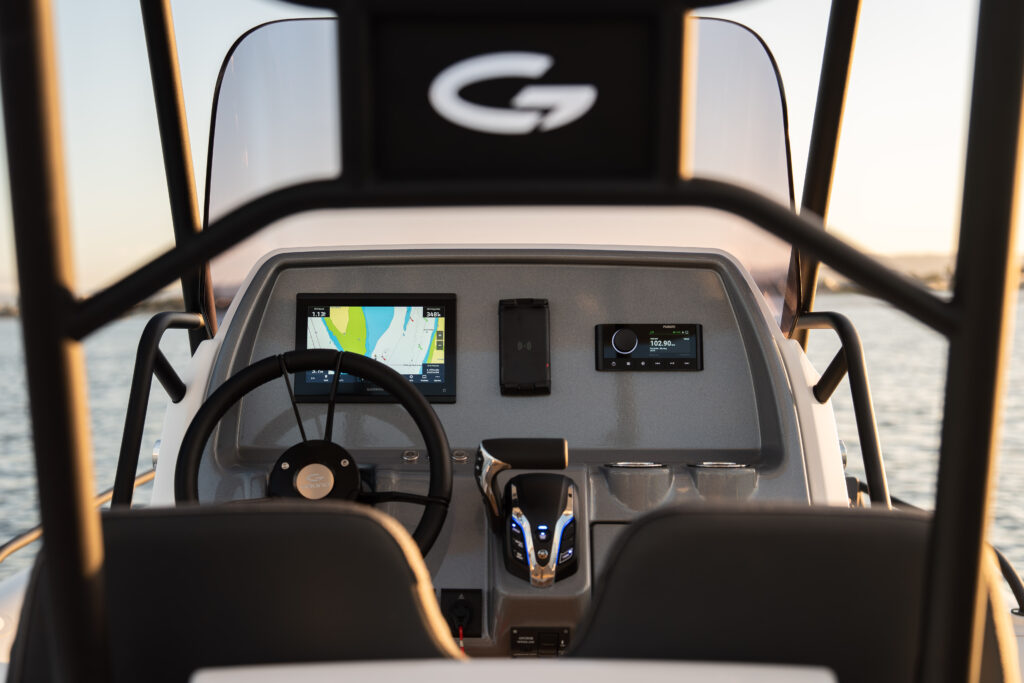
THE COCKPIT
A thing you don’t see very often on something subseven metres is a proper bar fridge, as in a fair-dinkum stainless fridge with a door, not a drawer fridge. Although if I had to be picky the one thing that could be improved, and it’s only because I suffer from power anxiety born from too many overnight trips leaving no charge for a start in the morning. So, I would like to see the two start batteries separated into a house and start battery. The in-hull storage around the transom is abundant with two lockers either side, and the main locker sits above the bilge ensuring things are kept dry. This is all covered up by comfortable wrap around seating when cruising.
OUT THE BACK
There is plenty of space to get in and out of the water, particularly on the port side where the ladder goes into the water a long way, so you don’t have to be a contortionist to find your way out of the drink.
The spoiler at the back has all the fastenings for whatever you want to tow – toys, skiers or even towing your mate home. It looks the business too, with a wing top straight from the Formula One track.
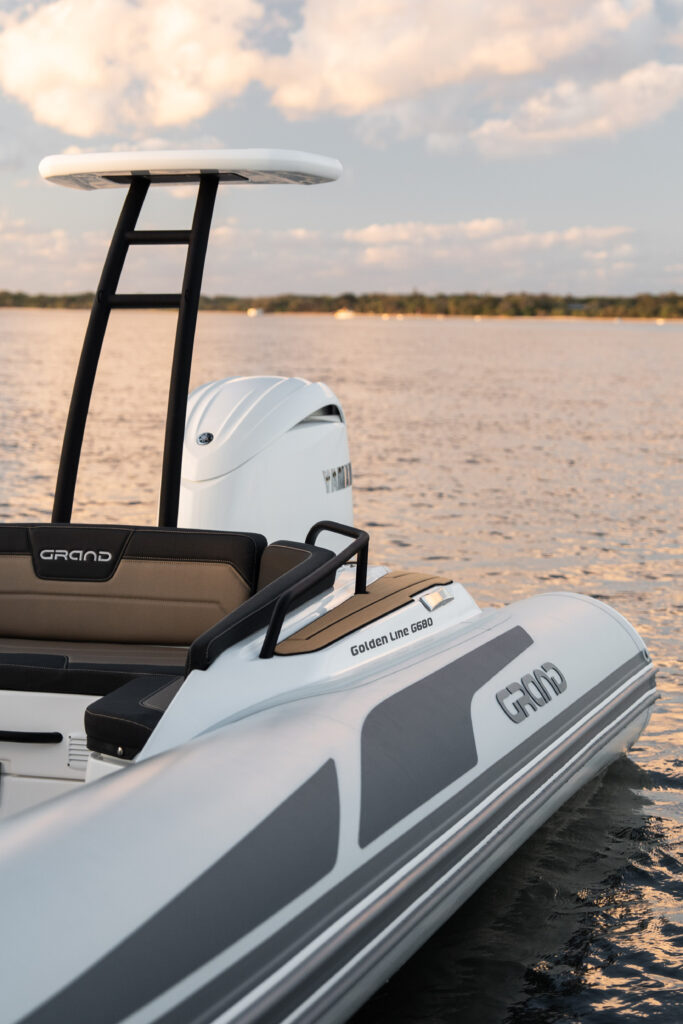

THRUST
Feeding the white, 200-horsepower Yamaha steer-by-wire – a handsome pearlescent white unit that glints in the sun – is a 200-litre fuel tank positioned slightly aft of midships. The 200-hp is the maximum for this vessel as recommended, but I felt a 150-hp would have done the trick. Then, as Dan says: “If you can, why not?”
THE RIDE
If you are feeling sleepy in the morning sun, you won’t be for long with the speed and turning capabilities of this RIB. Coming over the swell after catching six feet of air wasn’t as painful as one might expect with a relatively deep V bow slicing through the surface tension. At 35 knots pushing into a corner at almost full lock, there was only a slight bit of cavitation thanks to the long leg of the Yamaha. But it must be noted that the leg was slightly trimmed up which is the preferred position at full noise with half a tank on board.
SUMMARY
For a retail price tag of just south of $150,000 this is a value for money unit. There is not a lot to add in terms of add-on extras, and my feeling is that there is not much this boat couldn’t tow with the 200-hp engine configuration. The design layout and placement of things is well thought out and it’s obvious there has been a lot of customer feedback, trial and error as well design consultation to come up with all the tricky features that set this RIB apart. In terms of improvement, using my own experience on the trip, the helm seat for the passenger’s side could do with one more handhold. But I did have a mad-dog swell-seeking Englishman on the helm who was keen to show me how well the vessel performs in the rough stuff.
SPECIFICATIONS
LOA 6.8m
WOA 2.64m
Passenger Capacity 12
Tube Chambers 5
Price from $98,000
Price as tested $148,700
PERFORMANCE DATA
KNOTS LPH
14.6 12.7
20 16.6
25 22.9
30 33.3
35 41.5



